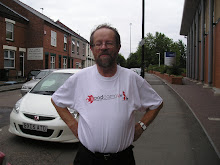 We found our way to Ickworth House today. Turns out to be only about ten minutes from where we’re staying. It’s not as old as the other two National Trust homes we’ve been to, and it’s larger and more imposing than either of them. An enormous rotunda (see picture) is the centrepiece of the building, with east and west wings extending from it. The interior of the rotunda is about all that’s available to view; the west wing contains a large restaurant, foyer and the obligatory shop while the east wing has been formed into a hotel.
We found our way to Ickworth House today. Turns out to be only about ten minutes from where we’re staying. It’s not as old as the other two National Trust homes we’ve been to, and it’s larger and more imposing than either of them. An enormous rotunda (see picture) is the centrepiece of the building, with east and west wings extending from it. The interior of the rotunda is about all that’s available to view; the west wing contains a large restaurant, foyer and the obligatory shop while the east wing has been formed into a hotel.Ickworth must be one of the NT’s showpieces. Certainly a large amount of money has gone into keeping it up to scratch, aided by the fact that the family who owned it put plenty of solid money into it over various generations.
The house and gardens (some 1800 acres of them!) have been in the Hervey family since the mid-fifteenth century, but Ickworth House was only begun in 1795. It was the creation of a rather eccentric member of the Hervey family: Frederick, the 4th Earl of Bristol and also the Bishop of Derry, neither places being remotely near Ickworth, as far as I know. Frederick can’t have had a lot of time to be a Bishop, as he spent much of his life collecting things for his house – mostly abroad in Europe. Consequently, the house has a host of marvellous silverware, gold plate, various statues and busts, an intriguing collection of metal fish thingees - I can’t remember their purpose – around thirty miniatures, stuff from the Orient, and umpteen paintings, mostly portraits. Included amongst these are works by Gainsborough, Hogarth, Reynolds, Poussin, Velasquez and Titian. (I think there are actually only one each of the latter two artists, but the Titian is a superb portrait, the head shining out of a dark background.)
Besides all this, the design of the house is breathtaking. You walk into the Rotunda and there’s a large foyer, with a ceiling reaching up some thirty feet. When I say ceiling, I actually mean a glass roof, a curved glass roof. (One person there today was observantly asking: were the panes of glass actually curved, or just the shape of the roof as a whole?). Beyond this glass ceiling the building goes up further, and by stretching your neck you can see a metal spiral staircase clinging to the side of the upper storeys, and more storeys above that again. As Celia said, you wouldn’t want to drop anything while you were up there.
Everything in every room smacks of wealth, and beauty, and good taste. The walls are covered in portraits, many of them nearly life size. I think there are over 200 portraits around the place. But the furniture and fittings and adornments are all top of their class. (Only one pair of ornaments, candleholders in the form of a couple of very pink cherubs, seemed kitsch rather than classy.)
There are around 7,000 books in the various shelves and the library. Many of them were rebound at the beginning of the 19th century to make sure they stayed whole. Apparently most have been read at some point, as there are pencil notes scattered throughout. (Those people who will insist on annotating their own books!)
The house and gardens were given to the National in 1956 in lieu of death duties. The east wing was supposed to stay in the hands of the family, but the rather notorious 7th Marquess of Bristol sold it to the NT in 1998. He had managed to blow a £30 million pound fortune away in his short life – he died at 44, possibly from AIDs and definitely after having been involved in the drug scene. The next Marquess in line tried to buy the east wing back, but the NT refused. However, they did complete the unfinished west wing, in partnership with Sodexho Prestige.

No comments:
Post a Comment